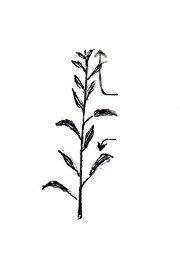|
|
The development of the stem of a young tree is affected considerably by the amount of time that its pot is left in the same spacing with the rest of the crop around it. |
|||
|
After a certain length of time and growth, whether in ground beds or the field, or in containers of any size, close spacing of tree seedlings has some very detrimental effects. It:
Each of these factors can stimulate vertical growth, which is not desirable.
Many cultural factors can affect these leaves, including nutrient deficiencies (nitrogen, phosphorus, potassium or magnesium), toxicity of excess micronutrients such as manganese, copper or boron, or damage from sodium, bicarbonates or chlorides. Anything interfering with normal root activity such as root rot or other diseases,insect or nematode damage, being root bound, persistent overwatering or with a poor drainage and low oxygen situation in the soil. Getting these conditions right is the challenge of growing a good seedling. What isn't generally realised, however, is that they can also be seriously affected by overcrowding which prevents light from reaching them to allow photosynthesis to occur. How much space is enough to prevent this? The smaller the pot and the closer together they are, the sooner the plants will need to be moved on and spaced to avoid the loss of light to the lower leaves. Sooner or later, plants in any size pot will need to be given additional space between them. This cannot be done on a predetermined calendar date, since it depends on the growth rate, the species, the time of year, the fertilizer levels and the other factors that control growth. With additional space, most tree species develop more side branches; spacing is critical for this, and leaves on these branches are the primary contributors of energy for stem and root growth. These branches should not be removed prematurely, and the criterion for the timing of this is that sufficient stem diameter and taper must have developed to give support to the top of the tree before any are taken off. When the lower branches are prevented from forming, or are densely shaded, or are taken off too soon, the stem development is typically like a piece of pipe: that is, all sides of the trunk are parallel. Once this situation develops, it is likely to persist even if the spacing is improved. The foliage is mostly at the top of the tree, and the energy which it produces is used first there. Any excess travels down the trunk in the phloem tissue, but is tapped by what branches remain so that little reaches the trunk at the base of the tree to cause the growth that gives the desirable taper. In addition to this, the more you prune off the lower branches and reduce leaf surface, the more the top extends vertically trying to produce more leaf surface to replace what has been lost. On the other hand, once the tree has produced a good taper, the lower branches can gradually be removed without losing the taper. These trees usually have a superior root system to match their strong trunk, which supplies more water and nutrients to the leaves and in turn increases the amount of energy available for all parts of the tree to draw on for growth. Trees with a good taper should not need staking. Their trunk allows them to respond to wind by bending along their whole length like a good fishing rod. Trees with no taper that have to be staked, flex just above the soil line in a wind, and are easily damaged. Dr Carl Whitcomb is president of Lacebark, Inc. Publications and Research, Stillwater, OK. Tel 405 377 3539
|
||||

